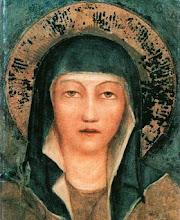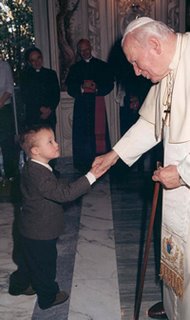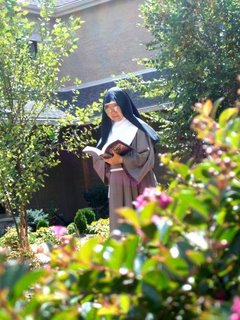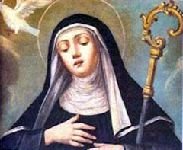
"Brother Sun, Sister Moon" (1972)
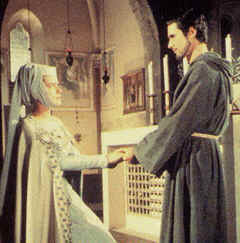
"Francis of Assisi" (1961)
In preparation for my annual St. Francis Day party on Wednesday, I was trying to decide between the two English-language films about the Seraphic Father- the popular 1972 Franco Zefirelli "Brother Sun, Sister Moon" and 1961's "Francis of Assisi." Unless anyone out there can make a quality film about St. Francis within the next two days, I pretty much have to decide between the two. It's definitely a hard pick, because both films have their pros and cons.
Until I watched "Francis of Assisi," I was a little bit harsh in my critique of "Brother Sun, Sister Moon." Indeed, "Brother Sun, Sister Moon" has the flaw of being like cotton-candy- sweet to taste, but it doesn't have much substance. The audience is left to guess what is going on inside Francis' head when he decides to give his life completely to God….and of course, the audience must guess about the "God" part, too, since God isn't mentioned very much in the film. The characters are rather one-dimensional- Clare is the flighty "flower child", Pietro Bernadone is "corrupt," and so on and so forth. Moreover, many have criticized the film for portraying Francis and his followers as a gaggle of "hippies."
I. Clare’s RoleJust as "Brother Sun, Sister Moon" was a sign on the times in which it was made, "Francis of Assisi" is also reflective of late 50s/early 60s moviemaking. "Francis of Assisi" plays like a typical 60s overwrought costume-drama, especially during the first forty-five minutes.
Until about halfway through the film, I was irked about how Clare is reduced to nothing more than a static figure in a love-triangle…..and God isn't one of the parties in that love triangle.\n Francis makes comments such as "I've always been in love with Clare," which would lead one to think that her vocation is nothing more than attempt to be with Francis. Nonetheless, Dolores Hart, the actress who plays Clare, rescues her role about halfway through the film and when she begins to discern her vocation to become a nun, the fact that she was initially portrayed as a flighty "lady in waiting" begins to make sense. When Clare hears Francis preach on Palm Sunday and decides that she wants to become a nun, she realizes that a life dedicated to God will free her from the constraining life of a noblewoman. She is shown deep in prayer before the Blessed Sacrament as she discerns her vocation. While "Brother Sun, Sister Moon" presents us with the joyful and childlike Clare (which in themselves are beautiful traits), "Francis of Assisi's" Dolores Hart presents us with a prayerful, thoughtful Clare. The scene of Clare's investiture in "Francis of Assisi" is very detailed and beautiful- she is shown chopping off her hair and receiving the Franciscan habit….which, unlike the "bathrobe" that Clare wears in "Brother Sun, Sister Moon," is a genuine Franciscan nun's habit not unlike the habits that Poor Clares wear today. I also like the way that "Francis of Assisi" establishes that Clare is a cloistered nun.
Until about halfway through the film, I was irked about how Clare is reduced to nothing more than a static figure in a love-triangle…..and God isn't one of the parties in that love triangle. Francis makes comments such as "I've always been in love with Clare," which would lead one to think that her vocation is nothing more than attempt to be with Francis.
Nonetheless, Dolores Hart, the actress who plays Clare, rescues her role about halfway through the film. When she begins to discern her vocation to become a nun, the fact that she was initially portrayed as a flighty "lady in waiting" begins to make sense. When Clare hears Francis preach on Palm Sunday and decides that she wants to become a nun, she realizes that a life dedicated to God will free her from the constraining life of a noblewoman. She is shown deep in prayer before the Blessed Sacrament as she discerns her vocation. While "Brother Sun, Sister Moon" presents us with the joyful and childlike Clare (which in themselves are beautiful traits), "Francis of Assisi's" Dolores Hart presents us with a prayerful, thoughtful Clare.
As mentioned in one of my previous posts, playing St. Clare in this movie prompted the real-life Dolores Hart to explore the contemplative life. She ultimately joined
Regina Laudis Abbey, a lovely community of Benedictines in Connecticut, where she is now an abbess.
The scene of Clare's investiture in "Francis of Assisi" is very detailed and beautiful- she is shown chopping off her hair and receiving the Franciscan habit….which, unlike the "bathrobe" that Clare wears in "Brother Sun, Sister Moon," is a genuine Franciscan nun's habit not unlike the habits that Poor Clares wear today. Also interesting about this scene is that not only are Francis and his followers present, but the Benedictine nuns of a nearby abbey assist Clare in making her vows. This affirms the beautiful connection that the Poor Clares have with the Benedictines and was perhaps even a foreshadowing of Dolores Hart becoming a Benedictine! I also like the way that "Francis of Assisi" establishes that Clare is a cloistered nun after her investiture. In one beautiful line, Clare tells Francis, “you said that my path ahead of me would be strewn with thorns….but I’ve discovered that my life is filled with nothing but joy!”
II. Francis in Both Films
Why did Francis do what he did? It’s a question we might never be able to answer, but neither “Brother Sun, Sister Moon” or “Francis of Assisi” helps us in finding an explanation. The way in which Francis decides to give up his possessions in both movies is very different:
The better half of “Brother Sun, Sister Moon” focuses almost entirely on the period between Francis returning home from the war and publicly denouncing his material possessions. If you’ve watched “Brother Sun” as much as I have, you’ll notice that Francis hardly speaks at all during this part of the movie- it’s implied that he’s having what the world might construe as a “nervous breakdown.” That is, he realizes that his previous worldview just doesn’t work anymore. For the most part, I think that the “nervous breakdown” approach is very realistic and touching….but except for a few glances at the crucifix, the audience is left to guess whether or not God has anything to do with Francis’ decision.
Meanwhile, “Francis of Assisi” doesn’t bring any personal struggles into the picture of Francis’ discernment. In one battle scene, the background noise is muted and you hear the “voice of God” literally say “Francis, put away your sword and return to Assisi.” Faithfully, Francis listens. Nonetheless, this Charlton-Heston-esque “voice of God” is really the only time where God is factored into Francis’ decision. The audience doesn’t get the sense that Francis is “falling in love with God” in order to come to his decision. Thus, Francis’ character comes off as a bit one-dimensional during this part of the movie.
The biggest bone that I have to pick with “Francis of Assisi” is that the film completely erases any struggle that Francis had with his father, Pietro Bernadone. In reality, Pietro Bernadone was so furious with Francis for having “gone crazy” that he dragged his son before the Bishop of Assisi and tried to force him to publicly apologize. This was when Francis famously stripped off his clothing in the public square, renounced his father’s last name, and officially becomes Francis of Assisi. This scene is the focal point of “Brother Sun, Sister Moon”- no matter what you think of the rest of the film, I promise you that the scene in the public square will move you to tears. However, not only does the film “Francis of Assisi” omit this important turning point in St. Francis’ life, but it portrays Francis parting with his parents on friendly terms! Why is this such a big deal? We must realize that not only did Francis relinquish material goods, but he also gave up loyalty to his own parents in order to follow God more fully- we might be able to part with material possessions, but it is so incredibly difficult for us to choose God over those on earth whom we love so much.
“Brother Sun, Sister Moon” delves deeper into the relationship that Francis had with his early followers- the film explores why each of them chose to forsake their lives as nobleman in order to follow the little tramp of Assisi. While by the end of “Brother Sun,” Francis has only attracted about twelve followers, you feel as though you know who they are.
Since “Francis of Assisi” provides an overview of Francis’ entire life, we see his followers exponentially grow into an international movement. Hence, the audience doesn’t get to “know” any of his fellow brothers- we are left to guess why they follow him. Nonetheless, we are provided with an excellent picture of the way Francis had to struggle against Brother Elias and those who called themselves his “followers”….but who completely wanted to forsake his rule of poverty. The way that Francis is so gentle and faithful to the Gospel in the midst of this strife is very moving.
“Francis of Assisi” also delves into Francis’ later years, which we don’t see in “Brother Sun, Sister Moon.” The blessing of the animals and children is touching, as his Francis’ unconditional love towards the lepers. I particularly liked the scene when Francis visits the Saracens- it’s particularly relevant for this day and age. Here, we see Francis as acting very peacefully towards the Saracens but at the same time never relinquishing his faith in Christ’s redemption and the Truth of the Church. This stalwart faith is shown when he challenges the Saracens to a “trial by fire”- something that modern synopses of Francis’ life often forget to talk about. Nonetheless, this whole part of the movie illustrates that Francis had an unconditional love towards others that was founded in Christ.
The receiving of the stigmata is also a very beautiful scene in “Francis of Assisi.” When he climbs up to Mount Alverno, Francis is ill and his patience has been tried by his brothers. He begs to unite all of his sufferings with the sufferings of Christ and live out the rest of his life as a penance for the world- the ultimate act of love. Thus, the film establishes valid reasons for his being given the stigmata…..quite a lofty accomplishment for an early 60s costume drama!
So after writing this post of Proustian-proportions, you might be asking….have a come to a decision as to what movie to show at my party on Wednesday? Francis is such a complex figure and it’s impossible for any one movie to capture everything about him, so what movie to show really depends on the audience. For a “party movie,” I think I’d recommend “Brother Sun, Sister Moon”- it effectively captures the joyful, youthful Francis who longs for something more than what his society can offer him. However, for a more comprehensive look at Francis’ life and works, I recommend showing “Francis of Assisi.” I’d especially recommend showing “Francis of Assisi” to people who don’t know much about his life. Moreover, if you’re trying to introduce people to St. Clare, “Francis of Assisi” presents a much more prayerful, thoughtful young woman than does “Brother Sun, Sister Moon.”
Oh yeah, and one more thing I like about the 1961 film “Francis of Assisi”…..instead of the words “The End” showing up on the screen at the film’s finale, the screen reads “
Pax et Bonum!”


